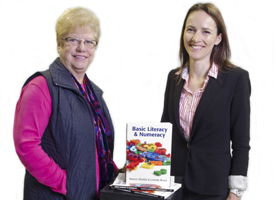Makes learning literacy and numeracy simple
Brenton Stacey
Public relations officer
Avondale College of Higher Education
Cooranbong, New South Wales, Australia
A new literacy and numeracy textbook by two Avondale lecturers is helping students improve their skills and their understanding of how to support those they teach.
Dr Marion Shields decided to write Basic Literacy & Numeracy three years after being asked to teach a new unit, Literacy & Numeracy for Teachers. She added information about punctuation and text types to an initial outline in the first year and other information in the second year. “By the third year I thought, This is ridiculous. We are using so much paper. So, I put it all together, called it a draft textbook and asked the students to work through it with me.”
She also tested the students and realised most of them needed to improve their literacy and numeracy skills—students struggled to achieve the 75 per cent to pass the test. “After I finished teaching the unit in 2011—[co-author Lorinda Bruce taught the unit this past year]—students were seeking me out and saying, ‘You’re the one who wrote that book, aren’t you?’ I said, ‘Yes. They said, ‘It’s so simple. This is the first time we’ve ever really understood this.’”
To ease understanding, Basic Literacy & Numeracy features a bigger font size, a graphical icon to identify practice exercises—answers are in the back of the book—simple headlines and white space. “If a student struggles with numeracy, having a page crammed full of information terrifies them.”
The book also features a section, provided by Lorinda, on information and communications technology resources. The section includes lists of interactive resources, iPad and iPhone applications and websites.
Marion will share her reasons for writing the book at a seminar on Literacy Support for Struggling Readers in the Classroom organised by the Hunter branch of the Australian Association of Special Education in Charlestown tonight. “I see the value of giving students a fair go,” she says. “When intelligent students understand why they can’t do something, it’s not so frightening. Research shows that if motivated students with literacy and numeracy learning disabilities have a sympathetic, supportive teacher in an encouraging environment, they will always do better than the same students whose teachers just don’t bother. Attitude and a sense of self-empowerment are big factors in helping students overcome their disabilities.”
Basic Literacy & Numeracy (David Barlow Publishing) is available from the Avondale College of Higher Education bookshop for $44.

